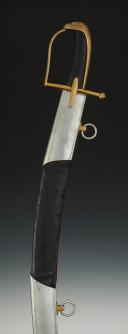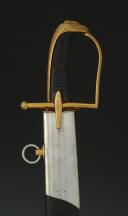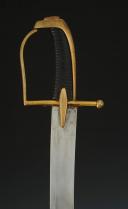
Hussar Troop Saber, Year IV model, Revolution (from 1792 to around 1802).
Sold out
Hussar Troop Sabre, model year IV, Revolution.
Rose brass hilt, guard with a single branch stamped with the "M" under a toothed wheel of J.J. Mouton, civil inspector from November 1793 to March 1798, and the oval-shaped "LW" stamp within a beaded crown of B.P.C. Levavasseur, inspector from March 1798 to September 1803, long-tailed pommel, handle in black waxed calf leather. Curved blade with hollow facets, length 80.9 cm, width at the base 4 cm, engraved on the back with "Mfture de Klingenthal" and stamped similarly to the handle. Scarlet cloth tie. Wooden scabbard covered in black waxed leather with two large steel fittings with brass belt loops and steel rings. Steel blade. Brass chape with a cup cavity entrance.
France.
Revolution.
Very good condition, some oxidation spots on the blade, leather of the scabbard with a seam accident and some wormholes, missing calf leather on the handle.
NOTE:
Michel Pétard writes in his book "The History of Hussar Sabres from Louis XIV to the Present Day," Canonnier Editions 2010, "The republican version of the 1777 sabre is distinguished from its direct ancestor by its iron-trimmed scabbard. No significant archives allow us to know its origin, but the comparison of markings on many specimens demonstrates manufacturing ranging from around 1792 to 1798 and predominantly originating from Klingenthal. Additionally, privately requisitioned industry productions were also very present, sometimes using blades forged in Klingenthal. Of course, the large fleur-de-lis engraved on the blade under the monarchy until 1792 gives way to the monogram "Repe" "Franse" engraved on both sides of the blade. The back always featuring ‘KLINGENTHAL’ engraved in bold capitals. Sabre figure 33: Klingenthal stamps between 1793 and 1798. Sabre figure 34: Klingenthal stamps between 1798 and 1802."
Rose brass hilt, guard with a single branch stamped with the "M" under a toothed wheel of J.J. Mouton, civil inspector from November 1793 to March 1798, and the oval-shaped "LW" stamp within a beaded crown of B.P.C. Levavasseur, inspector from March 1798 to September 1803, long-tailed pommel, handle in black waxed calf leather. Curved blade with hollow facets, length 80.9 cm, width at the base 4 cm, engraved on the back with "Mfture de Klingenthal" and stamped similarly to the handle. Scarlet cloth tie. Wooden scabbard covered in black waxed leather with two large steel fittings with brass belt loops and steel rings. Steel blade. Brass chape with a cup cavity entrance.
France.
Revolution.
Very good condition, some oxidation spots on the blade, leather of the scabbard with a seam accident and some wormholes, missing calf leather on the handle.
NOTE:
Michel Pétard writes in his book "The History of Hussar Sabres from Louis XIV to the Present Day," Canonnier Editions 2010, "The republican version of the 1777 sabre is distinguished from its direct ancestor by its iron-trimmed scabbard. No significant archives allow us to know its origin, but the comparison of markings on many specimens demonstrates manufacturing ranging from around 1792 to 1798 and predominantly originating from Klingenthal. Additionally, privately requisitioned industry productions were also very present, sometimes using blades forged in Klingenthal. Of course, the large fleur-de-lis engraved on the blade under the monarchy until 1792 gives way to the monogram "Repe" "Franse" engraved on both sides of the blade. The back always featuring ‘KLINGENTHAL’ engraved in bold capitals. Sabre figure 33: Klingenthal stamps between 1793 and 1798. Sabre figure 34: Klingenthal stamps between 1798 and 1802."
Reference :
23504

Next update Friday, december 19 at 13:30 PM
FOR ALL PURCHASES, PAYMENT IN MULTIPLE CHECKS POSSIBLE
bertrand.malvaux@wanadoo.fr 06 07 75 74 63
SHIPPING COSTS
Shipping costs are calculated only once per order for one or more items, all shipments are sent via registered mail, as this is the only way to have proof of dispatch and receipt.
For parcels whose value cannot be insured by the Post, shipments are entrusted to DHL or Fedex with real value insured, the service is of high quality but the cost is higher.
RETURN POLICY
Items can be returned within 8 days of receipt. They must be returned by registered mail at the sender's expense, in their original packaging, and in their original condition.
AUTHENTICITY
The selection of items offered on this site allows me to guarantee the authenticity of each piece described here, all items offered are guaranteed to be period and authentic, unless otherwise noted or restricted in the description.
An authenticity certificate of the item including the description published on the site, the period, the sale price, accompanied by one or more color photographs is automatically provided for any item priced over 130 euros. Below this price, each certificate is charged 5 euros.
Only items sold by me are subject to an authenticity certificate, I do not provide any expert reports for items sold by third parties (colleagues or collectors).
FOR ALL PURCHASES, PAYMENT IN MULTIPLE CHECKS POSSIBLE
bertrand.malvaux@wanadoo.fr 06 07 75 74 63
An authenticity certificate of the item including the description published on the site, the period, the sale price, accompanied by one or more color photographs is automatically provided for any item priced over 130 euros. Below this price, each certificate is charged 5 euros.
Only items sold by me are subject to an authenticity certificate, I do not provide any expert reports for items sold by third parties (colleagues or collectors).









